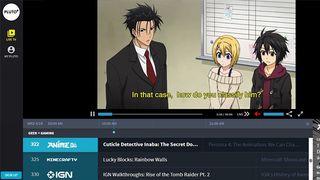Pluto TV Will Expand Its Programming Orbit

Pluto TV, the free, ad-based over-the-top TV service, is on the hunt for more content from digital and traditional programmers as it looks to expand both its lineup and its viewing base.
“We’re looking at a wide array of content to work with,” Robert Magdlen, a former NBCUniversal executive recently appointed Pluto TV’s chief programming officer, said. “In terms of opportunities, it’s really about finding programming that delivers interests, news and passion.”
For example, an anime enthusiast might not want to pay for a subscription VOD service focused on that content, but that person will still have interest in a free channel catering to that interest on a 24/7 basis, he explained. Additionally, a technology culture fan hasn’t been served in that way since the closing of G4, the network formerly known as TechTV. Pluto TV thinks it can fill more content gaps as it looks to add 20 more channels during Q2 2017.
It’s already plugging many of them with its current lineup of more than 100 OTT channels, several of which are curated and programmed by Pluto TV, such as Anime All Day and Minecraft TV. It also features digital native channels, including Cheddar, the People Entertainment Network, Cracked and Newsy, and networks that one would find in a traditional pay TV lineup, such as Bloomberg TV, CNBC and Sky News.
“It’s a unique bundle, not a skinny bundle,” Tom Ryan, Pluto TV’s CEO and cofounder, said.
In some respects, Pluto TV is part of a new wave of virtual multichannel video programming distributors (vMVPDs). The big difference is Pluto TV’s content slate and the fact that it’s free and serves as a counter to an expanding array of launched or coming paid OTT TV services such as Sling TV, DirecTV Now, YouTube TV, fuboTV and PlayStation Vue.
“Consider us as a TV networks group,” Ryan said. “We’re creating these channels partly under our own brands and partly under third-party brands. But in either case, we’re really delivering channels that fulfill the brand promise of the channel.”
Broadcasting & Cable Newsletter
The smarter way to stay on top of broadcasting and cable industry. Sign up below
And it appears that Pluto TV has found a sizable audience. In Q4 2016, Pluto TV announced it crossed 5 million monthly active users. “We’re way north of there now,” Ryan said, noting that the average session times on Pluto TV are more than an hour.
Those times “are really validating the original hypotheses of the business that lean-back viewing, linear programming is not going away even as TV moves from traditional to Internet distribution,” Ryan said.
Pluto TV’s viewership base runs the gamut, as it includes cord-cutters, cord-nevers and a “significant percentage” of people who already get a pay TV subscription, Ryan said.
Pluto TV makes its hay by selling ad pods in its programming hours, and believes that its focus on free content is a differentiator amid the influx of subscription-based vMVPDs.
But is Pluto TV tempted to add a paid option?
“I wouldn’t rule out any evolution of the business,” Ryan said. “It’s a fast-evolving market.”
Pluto TV has focused distribution on OTT platforms such as iOS, Android, Android TV, Web browsers, Fire TV and Roku players, and Apple TV boxes, but sees some additional opportunities as cable operators and other pay TV providers start to weave online video into their lineups.
MVPD DEALS A POSSIBILITY
Comcast, as one example, has already integrated Netflix with its X1 platform, and is working to tie in YouTube and Sling TV as well. Frequency, Wurl TV and Zone TV, meanwhile, have also developed digital OTT offerings that are designed to fit alongside a pay TV operator’s legacy TV lineup.
For Pluto TV, some of that work is already underway. U.K.-based Sky, also one of Pluto TV’s investors, has tapped the company to deliver an online video section for Sky Q, its next-gen pay TV platform.
“We certainly see traditional distributors as interesting potential partners, and we’ve got a lot of inbound interest right now in how Pluto TV can partner with those distributors,” Ryan said.
